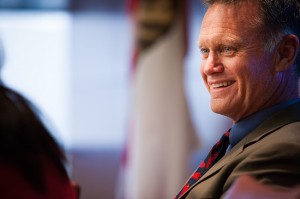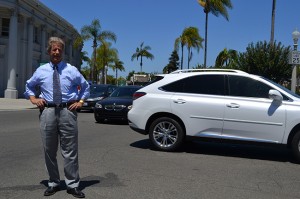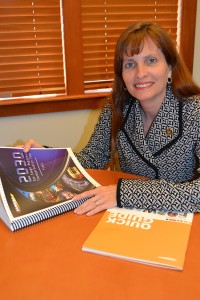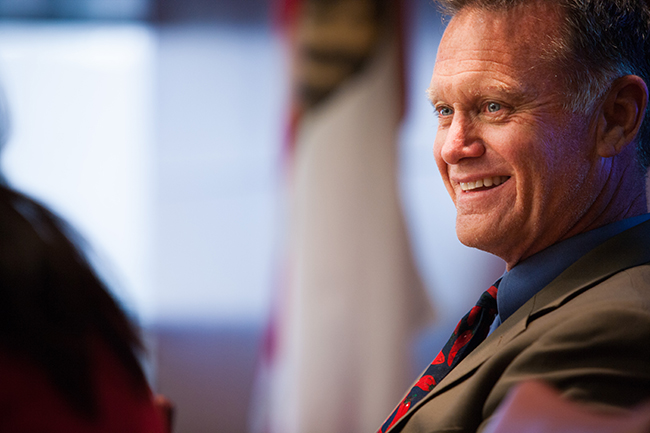Coronado is often viewed as an affluent resort town somewhat dissociated from the problems and policymaking of the larger San Diego area. Yet some of the region’s most involved decision-makers work and reside in Coronado.
The regional planning agency San Diego Association of Governments (SANDAG) counts among its board of directors Jack Dale, who chairs the board and runs a State Farm insurance office in Coronado, and Coronado City Council members Carrie Anne Downey, Mike Woiwode, and Bill Sandke.
SANDAG operates under the idea that the whole is greater than the sum of its parts. The public agency is comprised of local representatives — mayors, council members, and county supervisors — from San Diego County’s 18 cities and county government. They look at the San Diego region in its entirety for decision-making on big issues like allocation of resources and public transportation needs. Dale, who is also a longtime Santee City Council member, said SANDAG directors have the weighty task of balancing their own community’s needs against the needs of the larger region. “My joke is, I have to think and vote regionally but speak with a Santee accent. Mike, Bill and Carrie have to do the same thing, representing the concerns of Coronado.”
One of SANDAG’s most important duties is to administer TransNet money, a half-cent sales tax that helps fund regional transportation projects including highway expansions, trolley extensions, bike paths and transit programs. For instance, in July the SANDAG board approved 29 projects to receive $15 million in smart growth and active transportation funds; of that, Coronado was awarded a $90,000 grant, to be matched by the city, to improve local walking and biking amenities.
Every city has one primary representative and two alternates. For Coronado, Downey currently serves as the primary with Woiwode and Sandke as the alternates. When Downey isn’t able to attend a meeting, she asks one of the alternates to take her place.
SANDAG’s board directors are voting members who receive insight and input from staff planners, engineers and researchers, as well as advisors from Imperial County and Mexico, the U.S. Department of Defense, Caltrans, the San Diego Unified Port District, Metropolitan Transit System and North County Transit District, the San Diego County Water Authority, and the Southern California Tribal Chairmen’s Association.
Within the SANDAG structure are policy advisory committees addressing issues including the border, the environment, public safety, land use, regional growth and transportation.
“There are a lot of pieces to SANDAG,” explained Woiwode, who also chairs a military working group he helped start.
The SANDAG board meets as a group twice a month, though meeting schedules for policy groups and subcommittees vary from once a month to quarterly. Board directors receive nominal compensation for some meetings, typically about $150, Downey said.
By attending meetings, reading up on agenda items, and answering calls and emails from constituents, Downey estimates she dedicates 15 to 20 hours a week to SANDAG duties.
Public input is the final piece of the SANDAG puzzle. The agency works to encourage citizen participation in its processes, through public outreach programs, open meetings, and social media interaction on platforms including Twitter, Facebook and YouTube.
SANDAG’s major objectives currently include finalizing a long-term strategy called San Diego Forward: The Regional Plan. With population growth projections through 2050 as its impetus, the plan aims to create a sustainable transportation network — including freeway improvements, trolley extensions, train track additions, better bus routes, and new bikeways — that will efficiently move people and goods while reducing greenhouse gas emissions and preserving San Diego’s quality of life.
The San Diego region is expected to expand by nearly 1 million people by 2050. Coronado, meanwhile, is projected to grow to 27,907 residents by 2050, a 14 percent increase from the year 2000, according to data gathered by SANDAG.
Downey and Woiwode agreed that the population growth anticipated for Coronado is negligible. Tight zoning restrictions and a scarcity of available land will keep Coronado’s population numbers in check. Housing in Coronado is expected to grow only 3 percent over the 50-year period considered by SANDAG.
Still, Coronado residents will no doubt feel the effects of a burgeoning region, explained Woiwode. “Chances are pretty good that if you live in Coronado, you don’t work in Coronado. If you’ve got to get someplace outside Coronado, the stuff that gets done under these SANDAG projects is going to influence how you get there and how fast you get there,” he said.
“And, some residents may prefer that there be less traffic in Coronado from people who don’t live here. If the projects are built in such a way that they encourage carpooling and public transit and other modes of transportation, or telecommuting or other sorts of things to reduce commuter traffic, then that’s a benefit to the residents of Coronado as well. We can have a much bigger affect on traffic in our city if we can change the commute patterns in the region,” said Woiwode.
San Diego Forward puts an emphasis on mass transit and rideshare opportunities, a reflection of what many predict for the future of transportation. “We’re hopefully going to get more people out of their cars. Because that’s the thing we fully expect: in the next 40 years, how we move around is going to change,” Downey said.
“In this region, we simply cannot build enough highways to move people. Nor can we lay enough tracks for trolleys, nor have enough buses,” Dale said. “There’s no one grand solution. It’s synergistic. Maybe we’ll have more people working from home. Maybe people will be in a position where they can bike to work, or live closer to work.”
At its best, explained Dale, San Diego Forward will create a transportation framework for expected growth in an unknown future. “When you start planning 20 to 50 years away, so many things are going to change. Some of these visionary guys, they’ll tell you planning 10 years out, you’re wasting paper,” said Dale. “When we think about 2050, we’re doing the best we can at knowing how many people are going to be here and where they’re going to live, what they’ll need in terms of education and jobs. But whether they’re riding the trolley or driving a hybrid, we’re just trying to consider as many choices as we can.”
Transportation is a tricky topic for Coronado. While state and federal agencies tend to make transit decisions based on how quickly and efficiently the largest quantity of people and goods can get from one place to another, the residents of Coronado are calling for traffic-calming measures — particularly along the San Diego-Coronado Bridge and Third and Fourth streets.
Coronado lawmakers recognize that regional transportation plans will directly impact the community for many years to come. “The things that influence Coronado most directly are regional issues that are transportation related. This is our opportunity to participate in planning that,” Woiwode said. “The regional plan has everything to do with our ability to enjoy our quality of life.”
Downey agreed: “This planning process is one of the mechanisms that allows our elected officials to be involved in decisions that can either create more traffic or relieve traffic. That’s why we care.”
While the number of Coronado residents won’t increase greatly in the coming decades, regional growth will still have implications for Coronado’s character, according to Dale. “Coronado works very hard to take its past with it into the future,” he said. “Growth isn’t going to come from more people living here, though people are going to live longer and have kids. As this region grows, Coronado will experience it — there will be more people at the beach, more people at our parades, more people at the lighting of the Christmas tree.”
“SANDAG is involved in making long-term planning decisions, mostly in transportation. We’re trying to assist in decisions for the region, to minimize negative impacts while maximizing positive impacts,” said Dale.




